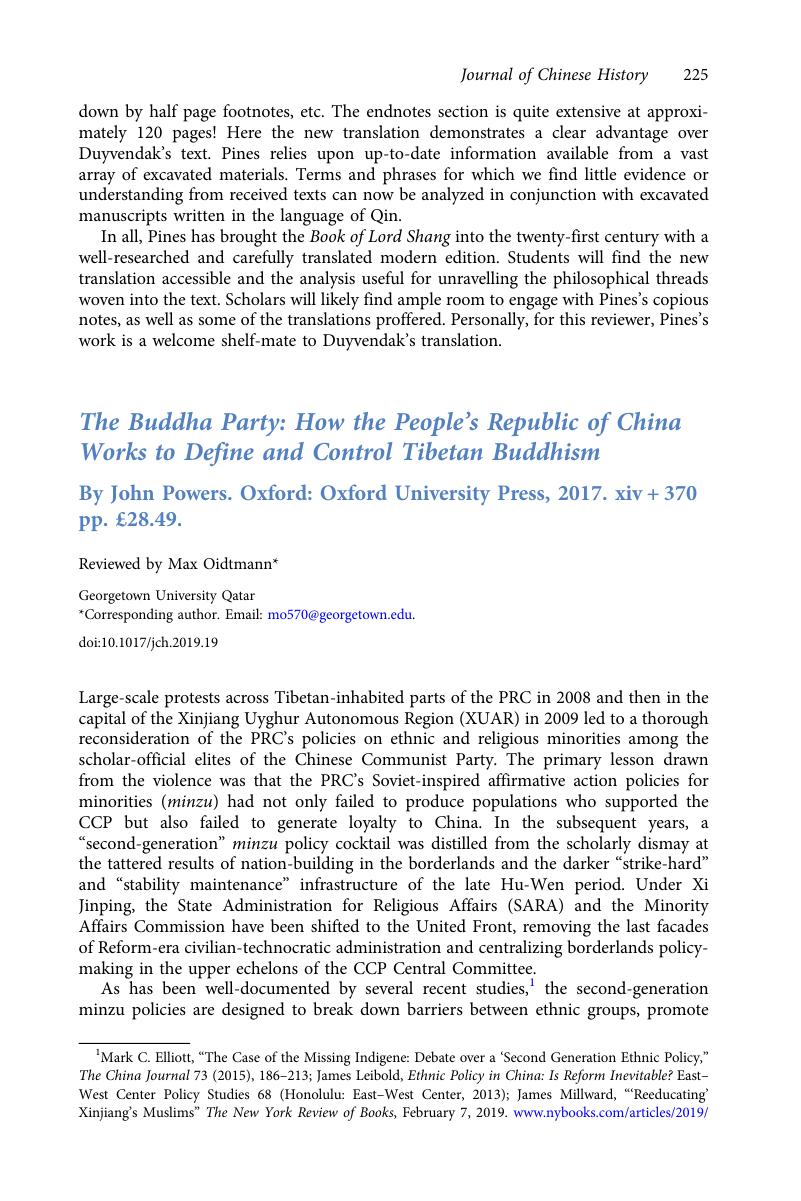No CrossRef data available.
Published online by Cambridge University Press: 27 September 2019

1 Elliott, Mark C., “The Case of the Missing Indigene: Debate over a ‘Second Generation Ethnic Policy,” The China Journal 73 (2015), 186–213CrossRefGoogle Scholar; Leibold, James, Ethnic Policy in China: Is Reform Inevitable? East–West Center Policy Studies 68 (Honolulu: East–West Center, 2013)Google Scholar; James Millward, “‘Reeducating’ Xinjiang's Muslims” The New York Review of Books, February 7, 2019. www.nybooks.com/articles/2019/02/07/reeducating-xinjiangs-muslims/; and Roberts, Sean R., “The Biopolitics of China's “War on Terror” and the Exclusion of the Uyghurs,” Critical Asian Studies 50 (2018), 232–58CrossRefGoogle Scholar.
2 Schwieger, Peter, The Dalai Lama and the Emperor of China: A Political History of the Tibetan Institution of Reincarnation (New York: Columbia University Press, 2015), 64Google Scholar.
3 Oidtmann, Max, Forging the Golden Urn: The Qing Empire and the Politics of Reincarnation in Tibet (New York: Columbia University Press, 2018)CrossRefGoogle Scholar.
4 Yumiko, Ishihama, “The Notion of ‘Buddhist Government’ (chos rsid) shared by Tibet, Mongol, and Manchu in the Early 17th Century,” in The Relationship between Religion and State in Traditional Tibet, ed. Cüppers, Christoph (Lumbini: Lumbini International Research institute, 2004), 15–31Google Scholar; Yumiko, Ishihama, Shinchō to Chibetto Bukkyō : Bosatsuō to natta Kenryūtei (The Qing Dynasty and Tibetan Buddhist World: Qianlong Emperor who became a Buddhist King) (Tokyo: Waseda University Press, 2011)Google Scholar; Kung, Ling-Wei, “The Transformation of the Qing's Geopolitics: Power Transitions between Tibetan Buddhist Monasteries in Amdo, 1644–1795,” Revue d'Etudes Tibétaines no. 45 (April 2018), 110–44Google Scholar; Lan Wu, “Refuge from Empire: Religion and Qing China's Imperial Formation in the Eighteenth Century” (PhD diss., Columbia University, 2016).
5 Xizang zizhiqu lishidang'anguan eds, Qingdai Xizang defang dang'an wenxian xuanbian (Beijing: Zhongguo Zangxue, 2017), vol 4Google Scholar.
6 Erie, Matthew, China and Islam: The Prophet, the Party, and the Law (Cambridge: Cambridge University Press, 2016)CrossRefGoogle Scholar; Fischer, Andrew Martin, State Growth and Social Exclusion in Tibet (Copenhagen: NIAS, 2005)Google Scholar, and author, same, The Disempowered Development of Tibet in China (Lanham, MD: Lexington Books, 2014)Google Scholar; Makley, Charlene E., The Violence of Liberation: Gender and Tibetan Buddhist revival in post-Mao China (Berkeley: University of California Press, 2007)CrossRefGoogle Scholar; Benno Ryan Weiner, “The Chinese Revolution on the Tibetan Frontier: State Building, National Integration and Socialist Transformation, Zeku (Tsekhok) County, 1953–1958,” (PhD diss., Columbia University, 2012); Yeh, Emily T., “Blazing Pelts and Burning Passions: Nationalism, Cultural Politics, and Spectacular Decommodification in Tibet,” Journal of Asian Studies 72, no. 2 (May 2013), 319–44CrossRefGoogle Scholar.
7 On p. 110 of The Buddha Party, Powers accuses Chen of making a variety of historical mistakes including claiming that the Thirteenth Dalai Lama was identified using the Golden Urn and that Manchu officials attended the enthronement of the Fourteenth Dalai Lama. My examination of both the Chinese and English language versions of Chen's book did not find either of these factual errors.
8 See for instance, Qingying, Chen, Huofo zhuanshi: Yuanqi, fazhang, lishi dingzhi (Beijing: Zhongguo Zangxue, 2014)Google Scholar.